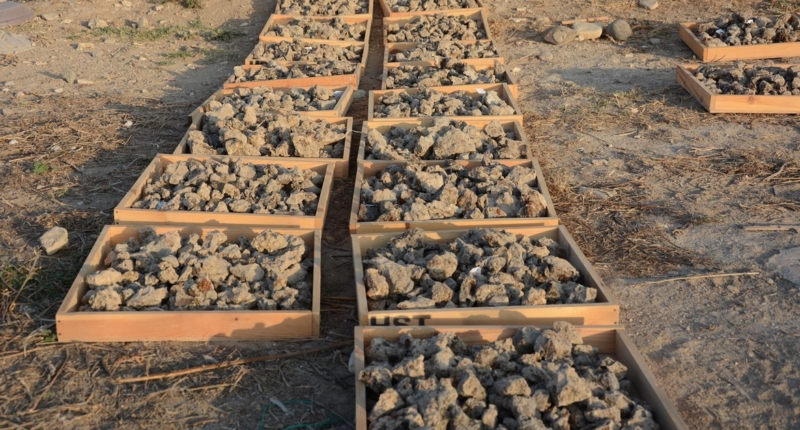Hala Sultan Tekke, a Cypriot village, was one of the most important trade hubs of the Late Bronze Age. Researchers from the University of Gothenburg have found evidence that suggests the city was significant in the early stages of international trade in the Mediterranean. The city was known for its strategic location, abundant reserves of copper, and the production of purple-dyed textiles and pottery. Excavations have also shown that the city was larger than previously thought, covering an area of some 25 to 50 hectares, which is a big city by that period’s standards. The collapse of the city around 1200 BC is believed to have been caused by the ‘Sea Peoples,’ as well as epidemics, famine, revolutions, acts of war by invading peoples, and a deterioration in the climate.
The Significance of Hala Sultan Tekke Village in the Late Bronze Age
A recent study by the University of Gothenburg has revealed the importance of the Cypriot village of Hala Sultan Tekke during the Late Bronze Age. The research team has excavated the area and found evidence that the village’s strategic location and abundant copper reserves made it one of the most crucial trade hubs in the Mediterranean during the early stages of international trade. The findings were published in the Journal of Archaeological Science.
Abundant Reserves of Copper
The research team has discovered that the village’s production of copper was in high demand. The excavation revealed significant amounts of imported pottery and luxury items made of gold, silver, ivory, and semi-precious gemstones. Professor Peter Fischer, the leader of the excavations, notes that the village’s copper production played a crucial role in its prominence as a trade hub.
Larger Than Previously Thought
The Swedish Cyprus Expedition began in 1927 to map the island’s archaeological history. The recent expedition led by Professor Peter Fischer at Hala Sultan Tekke began in 2010 and lasted for 13 seasons. The excavation uncovered that the village covered at least 25 hectares, 14 of which were its center, surrounded by a city wall. The excavation also found objects from this period scattered over an even larger area. Professor Peter Fischer notes that the village was more extensive than previously thought, covering an area of 25 to 50 hectares, which is a big city by the period’s standards.
Copper Production During the Bronze Age
Cyprus was the largest copper producer in the Mediterranean during the Bronze Age. The metal alloyed with tin formed the basis for making bronze, which was used for casting tools, weapons, and jewelry before iron started being used.
In conclusion, the excavation of Hala Sultan Tekke has uncovered evidence that highlights the village’s significance during the Late Bronze Age. Its strategic location and abundant copper reserves made it one of the most important trade hubs during the early stages of international trade. The excavation also revealed that the village was more extensive than previously thought. Cyprus’s copper production during the Bronze Age was essential to the production of bronze, which was used for various tools, weapons, and jewelry.
Hala Sultan Tekke: A Trade Hub in the Bronze Age
Peter Fischer, an emeritus professor at the University of Gothenburg and the leader of the excavation of Hala Sultan Tekke, has revealed that the village was one of the largest trade hubs in the Mediterranean during the Bronze Age. The city was strategically located in Cyprus, which had a well-protected harbor, making it favorable for trade. The excavation has shown that Hala Sultan Tekke was a large city by the period’s standards, covering an area of 25 to 50 hectares.
Extensive Copper Production
The excavation of the city has revealed the extensive copper production that took place in the form of smelting furnaces, cast molds, and slag. The ore used for copper production was brought from nearby mines in the Troodos Mountains. The workshops that produced copper were located in the north of the city to avoid the stench and soot generated by the production process. According to Peter Fischer, the production process would not be possible today, as it generates waste products like arsenic, lead, and cadmium.
Imported Goods
The city was also known for the trade of imported goods from neighboring regions such as Greece, Türkiye, the Middle East, and Egypt, as well as longer-distance imports from Sardinia, the Baltic Sea region, Afghanistan, and India. The excavation has revealed large quantities of imported goods, such as pottery, jewelry, and luxury items. These finds have helped in synchronizing and dating other finds across the Mediterranean, as the pottery from Hala Sultan Tekke had a unique spread during the Bronze Age.
Purple-Dyed Textiles and Pottery
Apart from copper production, Hala Sultan Tekke also produced highly sought-after purple-dyed textiles. The dye was extracted from purple dye murex species, and the city also exported pottery with painted motifs of humans, animals, and plants. The painted motifs were characteristic of Hala Sultan Tekke and were created by an artist referred to as the ‘Hala Sultan Tekke painter.’
Collapse of Hala Sultan Tekke
Trade in the city flourished for almost 500 years before collapsing just after 1200 BC. The prevailing hypothesis is that the ‘Sea Peoples’ invaded the eastern Mediterranean around this time, destroying its cities and bringing the Bronze Age civilizations to an end.
In conclusion, Hala Sultan Tekke was a significant trade hub during the Bronze Age, known for extensive copper production, imported goods, purple-dyed textiles, and pottery. The city’s location and well-protected harbor made it favorable for trade, and the pottery finds have assisted colleagues in synchronizing and dating other finds across the Mediterranean. The collapse of the city around 1200 BC is believed to have been caused by the ‘Sea Peoples.’
The Collapse of Hala Sultan Tekke
The prevailing hypothesis about the collapse of Hala Sultan Tekke around 1200 BC was that it was caused by the ‘Sea Peoples.’ However, recent research has given more nuance to this explanation. According to Peter Fischer, investigations have indicated that a deterioration in the climate, epidemics, famine, revolutions, and acts of war by invading peoples may have all contributed to the collapse. The research also suggests that people in search of better living conditions moved from the central Mediterranean towards the southeast, thus coming into conflict with the cultures in modern-day Greece, Cyprus, and Egypt.
Don’t miss interesting posts on Famousbio










